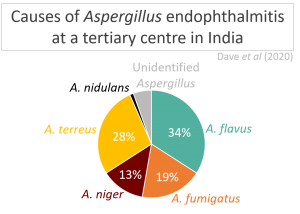Submitted by BenAtkinson on 9 August 2016
Aspergillus and other fungi thrive on various different organic substances, including agricultural crops intended for humans and animals. Numerous mould species, like Aspergillus, produce compounds known as mycotoxins (Zain, 2011). In relatively small quantities, which we ingest through normal consumption of food – mycotoxins have a very low risk of causing any adverse health effects. However, Aspergillus produces one of the most common mycotoxins – Aflatoxin – which has been demonstrated to be carcinogenic and associated with cirrhosis of the Liver. Furthermore, those who are exposed to high levels of mycotoxins through dietary, inhalation or epidermal means are likely to contract diseases known as mycotoxicoses. Although Aflatoxin is highly regulated in most countries, it can often contaminate food grains and has been well recognised as a public health issue for many years.
|
|
|
Maize cereals Tanzania |
Micrograms per kilo |
|
Aflatoxin concentration maximum requirement |
5 |
|
Aflatoxin concentration found |
5.7 – 204.5 |

Aflatoxin contamination on maize crop
Although aflatoxins are heavily regulated within Europe, it has now been indicated in a recent report that contamination of maize materials is predicted to rise significantly due to climate change. Battilani et al (2016) using a modelling approach of climate change, indicated that aflatoxin may become a more major issue in the agricultural industry, especially in a scenario where temperatures rise >2 degrees. If this model proves accurate, greater consideration must be given to reduce fungal growth of aspergillus and other species on food sources in order to reduce disease risk in agriculture.
News archives
-
Title
Date


